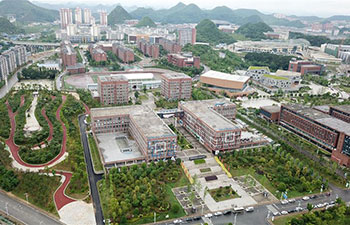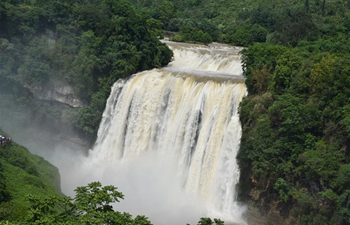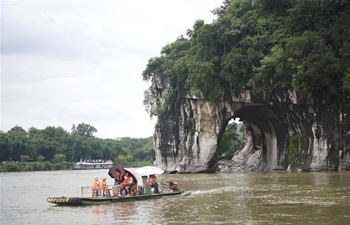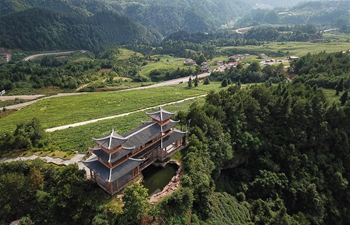SHIJIAZHUANG, June 9 (Xinhua) -- A decade after the launch of a pilot project to restore ecology in overexploited offshore seawaters, some local fish species which had disappeared, returned to the coastal area of Tangshan, a major industrial city in north China's Hebei Province.
Algae, shellfish and other fish grow abundantly and form the marine biologic chain in the 4,000-mu (266 hectares) seawater area, run by Tangshan Marine Ranching Co., Ltd.
In collaboration with leading domestic ocean research institutes, the private company has succeeded in transforming the desertified seabeds into an "undersea forest" and rebuilding the marine ecosystem, through dropping artificial reefs into the sea, artificial breeding and releasing of fish since 2009.
"The biomass in the area with artificial reefs underneath is 30 times that of the neighboring seawaters without reefs," said Zhang Zhenhai, chairman of the company.
"The ecological environment is in good shape in the piloted area," he said. This condition is in sharp contrast to what Zhang saw in the early 2000s when he planned to develop marine tourism but realized that the worsening offshore environment would only lead tourism to a dead end. Then he decided to restore the environment for sustainable development.
China's marine ranching must put ecological restoration and construction in the first place because the offshore areas in many regions have suffered severe damage due to excessive fishing and pollution, Zhang said.
At an accumulative investment of 150 million yuan (21.7 million U.S. dollars), the marine ranch at Xiangyun Bay in Tangshan is one of the first group of state-level demonstration marine ranching zones. The ranch's investment comes from government subsidy, bank loans and the company's own fund.
Nearly 200 local villagers have stopped traditional fishing methods due to decreasing fishery resources. They work for Zhang's marine ranch to offer tourists an ocean fishing experience, part of the company's recreational fishery program.
After making a living by fishing for 26 years, Yang Xingwu bought a leisure boat in 2011 and joined the fleet of 19 boats to showcase fishing for tourists at the Tangshan marine ranch developed by Zhang's company.
"We earned 40,000 to 50,000 yuan a year in the past from fishing, which was a tiring job and sometimes dangerous due to strong winds on the sea," said Yang, 52, from a village along the coast of the Bohai Sea.
Now, Yang invites tourists to his boat to experience the life of a fisherman. "It is much safer and stable. My annual income has doubled."
Zhang Hongrong, 86, from a fishing village in Laoting County in Tangshan, said until the 1970s, the Bohai Sea still abounded in fish, yet in recent years, some fish became almost extinct due to overfishing and pollution.
"It is really a blessing in my lifetime to see some fish species reappear in the sea," the old fisherman said.
Based on the restoration experiment, Tangshan Marine Ranching plans to plant eelgrass on a preliminary seawater area of around 6.5 hectares and extend the restoration project to 1,300 hectares of seawater area.
"The rehabilitation of marine ecology needs a big environment," said Zhang, chairman of the company. "After two or three years, the restoration project will show its ecological and economic benefits."
By the end of 2018, China had completed the construction of 233 marine ranches, which include 86 state-level demonstration marine ranching zones, producing considerable output in both economic and ecological terms, data with the Ministry of Agriculture and Rural Affairs show.
This year, the country aims to build more than ten national demonstration marine ranches, according to the ministry.

















